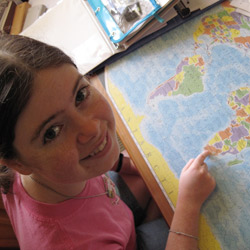Applewood School Goes on a Virtual World Cruise
On January 13, 2010, when the Seven Seas Voyager departed from San Diego for a 119-day cruise around the world, Natalie and I decided to set sail with the passengers and crew. Virtually, that is. With passage starting at $64,995, we thought we were getting quite the deal.
Prior to the date of departure, Natalie checked the weather in all ports of call. Based on what she learned about temperatures and rainfall, she made a packing list.
 We hung up a map of the world and Natalie marked all ports with red pins. We put together a jigsaw puzzle of the continents, which included country names and their capitals, as well as population and land mass information. When we finished putting it together, we slid it under the clear glass cover of our kitchen table for easy reference.
We hung up a map of the world and Natalie marked all ports with red pins. We put together a jigsaw puzzle of the continents, which included country names and their capitals, as well as population and land mass information. When we finished putting it together, we slid it under the clear glass cover of our kitchen table for easy reference.
We made a trip to the bookstore to select guidebooks, novels and short stories set in the countries we would be visiting, and we pulled out our “ship” – a 7 ½ lb. atlas (Geographica: The Complete Illustrated Atlas of the World) which was going to be our main means of transportation. Nearly every day, Natalie would read aloud an entry on one of the countries the ship was visiting, a routine called “Atlas.” It was our favorite activity of the day and Natalie liked to introduce each lesson as if it were a show: “Welcome, ladies and gentlemen, to another episode of your favorite show: Atlas!”
As we soon discovered, there is a wealth of information inside the pages of a good atlas, including details about weather, geography, economy, agriculture, politics, religion, culture, and history. After studying different graphing techniques utilized in The New York Times, Natalie constructed her own graphs based on the information she had gathered from the atlas. (See “What I Learned Sailing Around the World,” The Applewood Quarterly Vol. 1, Issue 3, Spring 2010, page 5).
We visited 30 countries, including Samoa, Fiji, Australia, Indonesia, Singapore, the Philippines, China, Vietnam, Thailand, Malaysia, Seychelles, Kenya, Tanzania, South Africa, Namibia, Benin, Togo, Ghana, Gambia, and Barbados.
While “visiting” South Africa, we read a riveting book of short stories about living under apartheid in South Africa titled Out of Bound by Beverley Naidoo. Natalie learned to sing the South African national anthem. We watched the movies “A World Apart” and “Invictus.”
In Tahiti, we visited the Paul Gauguin Museum and Natalie did additional research on Gauguin’s life and career, which she wrote about in a postcard she “sent” to William along the way.
Natalie’s photo essay on the “Plant and Animal Life of the Seychelles” uncovered interesting plant and animal species that stimulated Natalie’s interest in the natural world (See “Plant and Animal Life of the Seychelles: The 20th Stop on the World Cruise”, The Applewood Quarterly Vol. 1, Issue 3, Spring 2010, page 9).
While in Thailand, we went out for Thai food. And when we read that the ship’s passengers would stop for coffee, tea and homemade cake on a tour of Noumea in New Caledonia, Natalie and I did the same.
Little did I know how interesting it is to read an atlas. The next time someone asks, “What book would you want to have if you were stranded on an island?” I know exactly what I will answer.